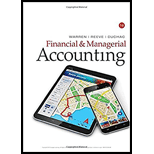
A.
Ratio analysis
It is the financial analysis tool for measuring the profitability, liquidity, capability and overall performance of a company.
Following are the two measures of liquidity:
- 1.
Current ratio : Current ratio is used to determine the relationship between current assets and current liabilities. The ideal current ratio is 2:1. - 2. Quick ratio: Quick ratio measures the immediate debt paying capacity of a business, which can be measured by dividing quick assets by the current liabilities. Quick assets represent cash, readily marketable securities, and
accounts receivable . - 3.
Working capital : Total current assets minus total current liabilities are the working capital of a company.
To Explain: That the working capital is a good measure of relative liquidity in comparing the two companies.
B.
Ratio analysis
It is the financial analysis tool for measuring the profitability, liquidity, capability and overall performance of a company.
Following are the two measures of liquidity:
- 1. Current ratio: Current ratio is used to determine the relationship between current assets and current liabilities. The ideal current ratio is 2:1.
- 2. Quick ratio: Quick ratio measures the immediate debt paying capacity of a business, which can be measured by dividing quick assets by the current liabilities. Quick assets represent cash, readily marketable securities, and accounts receivable.
- 3. Working capital: Total current assets minus total current liabilities are the working capital of a company.
To compute: The quick ratio for each company.
C.
Ratio analysis
It is the financial analysis tool for measuring the profitability, liquidity, capability and overall performance of a company.
Following are the two measures of liquidity:
- 1. Current ratio: Current ratio is used to determine the relationship between current assets and current liabilities. The ideal current ratio is 2:1.
- 2. Quick ratio: Quick ratio measures the immediate debt paying capacity of a business, which can be measured by dividing quick assets by the current liabilities. Quick assets represent cash, readily marketable securities, and accounts receivable.
- 3. Working capital: Total current assets minus total current liabilities are the working capital of a company.
To interpret: The results of quick ratio.
Want to see the full answer?
Check out a sample textbook solution
Chapter 10 Solutions
Bundle: Financial & Managerial Accounting, Loose-Leaf Version, 14th + CengageNOWv2, 2 terms Printed Access Card
- I want the correct answer with accounting questionarrow_forwardThe U.S. government agency with authority over the financial reporting requirements of publicly traded corporations is the .... AICPA FASB IRS SECarrow_forwardFinancial statements report the fair market value of a company. True Falsearrow_forward
- Asset, __________, and stockholders' equity accounts are known as balance sheet accounts.arrow_forwardFinancial accountingarrow_forwardDifferential Chemical produced 18,000 gallons of Preon and 39,000 gallons of Paron. Joint costs incurred in producing the two products totaled $8,500. At the split-off point, Preon has a market value of $11 per gallon and Paron $3.5 per gallon. Compute the portion of the joint costs to be allocated to Preon if the value basis is used.arrow_forward
 Financial And Managerial AccountingAccountingISBN:9781337902663Author:WARREN, Carl S.Publisher:Cengage Learning,
Financial And Managerial AccountingAccountingISBN:9781337902663Author:WARREN, Carl S.Publisher:Cengage Learning,

